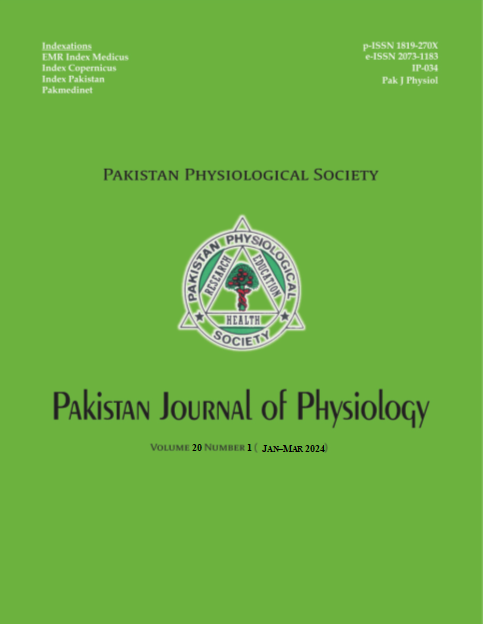INTEGRIN BETA2 GENE VARIANT CAUSING LEUKOCYTE ADHESION DEFICIENCY TYPE 1 IN A PAKISTANI FAMILY
DOI:
https://doi.org/10.69656/pjp.v20i1.1614Keywords:
Genetic Study, Whole Exome Sequencing, Sanger Sequencing, Leukocyte Adhesion Deficiency, FlowcytometeryAbstract
Background: Leukocyte adhesion deficiency type 1 (LAD1), an autosomal recessive condition, arises from partial or complete deficiency of CD18 expression. LAD1 patients commonly manifest recurrent skin and respiratory tract infections, delayed umbilical cord separation, and impaired wound healing due to hindered leukocyte migration. This study aims to clinically and molecularly diagnose LAD in a highly consanguineous Pakistani family, investigating a recurrent mutation within the integrin ?2 (ITGB2) gene. Methods: A comprehensive clinical and molecular diagnosis of LAD1 was made in on a patient from a consanguineous Pakistani family. Lymphocyte subset analysis was performed using a flow cytometer, followed by whole exome sequencing and DNA Sanger sequencing to identify the pathogenic mutation within the ITGB2 gene. Further to provide genetic counselling all the healthy siblings were also Sanger sequenced. Results: Flow cytometry indicated CD18 deficiency, while sequencing of the ITGB2 gene unveiled a nonsense mutation, c.186C>A, p. (Cys62*), located in exon four. This mutation segregates in an autosomal recessive pattern within the family. Conclusion: A mutation c.186C>A (Cys62*) in a patient of LAD1 was identified which is potentially pathogenic in nature.
Pak J Physiol 2024;20(1):15-8
Downloads
References
Ganesh A, Al-Zuhaibi SS, Bialasiewicz AA, Al-Abri R, Ahmed S, Al-Tamemi S, et al. Necrotizing Pseudomonas infection of the ocular adnexa in an infant with leukocyte adhesion defect. J Pediatr Ophthalmol Strabismus 2007;44(4):199–200.
Bousfiha A, Jeddane L, Picard C, Al-Herz W, Ailal F, Chatila T, et al. Human inborn errors of immunity: 2019 update of the IUIS phenotypical classification. Journal of Clin Immunol 2020;40(1):66–81.
Kambli PM, Bargir UA, Yadav RM, Gupta MR, Dalvi AD, Hule G, et al. Clinical and genetic spectrum of a large cohort of patients with leukocyte adhesion deficiency type 1 and 3: a multicentric study from India. Front Immunol 2020 Dec 16;11:612703.
Bashir MM, Hussain M, Ahmad D, Tipu HN. Leukocyte adhesion deficiency type 1 with low expression of CD 11b. J Coll Physicians Surg Pak 2018;28(6):S87–8.
Cox DP, Weathers DR. Leukocyte adhesion deficiency type 1: an important consideration in the clinical differential diagnosis of prepubertal periodontitis. A case report and review of the literature. Oral Surg Oral Med Oral Pathol Oral Radiol Endod 2008;105(1):86–90.
Bednarczyk M, Stege H, Grabbe S, Bros M. ?2 Integrins—multi-functional leukocyte receptors in health and disease. Int J Mol Sci 2020;21(4):1402.
Anderson DC, Springer TA. Leukocyte adhesion deficiency: an inherited defect in the Mac-1, LFA-1, and p150, 95 glycoproteins. Annu Rev Med 1987;38(1):175–94.
Solomon E, Palmer RW, Hing S, Law SK. Regional localization of CD18, the ??subunit of the cell surface adhesion molecule LFA-1, on human chromosome 21 by in situ hybridization. Ann Hum Genet 1988;52(2):123–8.
Wolach B, Gavrieli R, Wolach O, Stauber T, Abuzaitoun O, Kuperman A, et al. Leucocyte adhesion deficiency—A multicentre national experience. Eur J Clin Invest 2019;49(2):e13047.
Etzioni A. Leukocyte-adhesion deficiency, UpToDate 2020 [Available from: https://www.uptodate.com/contents/leukocyte-adhesion-deficiency.
Sun B, Chen Q, Dong X, Liu D, Hou J, Wang W, et al. Report of a Chinese cohort with leukocyte adhesion deficiency-I and four novel mutations. J Clin Immunol 2019;39:309–15.
Gorjipour H, Chavoshzadeh Z, Fahimzad A, Darougar S. Leukocyte adhesion deficiency type 1: A case series and review of the literature. EMJ Allergy Immunol 2019;4(1):95–100.
Human genome mutation databank. Human genome mutation data bank. Available at: https//www.hgmd.cf.ac.uk/docs/login.html.
Tipu HN, Raza R, Jaffar S, Khan A, Anwar MZ, Ahmad W, et al. B2 Integrin Gene (ITGB2) mutation spectra in Pakistani families with leukocyte adhesion deficiency type 1 (LAD1). Immunobiology 2020;225(3):151938.
Tipu HN. Leukocyte adhesion deficiency type I: A rare primary immunodeficiency disorder. Pediatr Allergy Immunol 2017;28(3):303–5.
Huang C, Lu C, Springer TA. Folding of the conserved domain but not of flanking regions in the integrin B2 subunit requires association with the a-subunit. Proc Natl Acad Sci 1997;94(7):3156–61.
Downloads
Published
How to Cite
Issue
Section
License

This work is licensed under a Creative Commons Attribution-NoDerivatives 4.0 International License.
The author(s) retain the copyrights and allow their publication in Pakistan Journal of Physiology, Pak J Physiol, PJP to be FREE for research and academic purposes. It can be downloaded and stored, printed, presented, projected, cited and quoted with full reference of, and acknowledgement to the author(s) and the PJP. The contents are published with an international CC-BY-ND-4.0 License.











